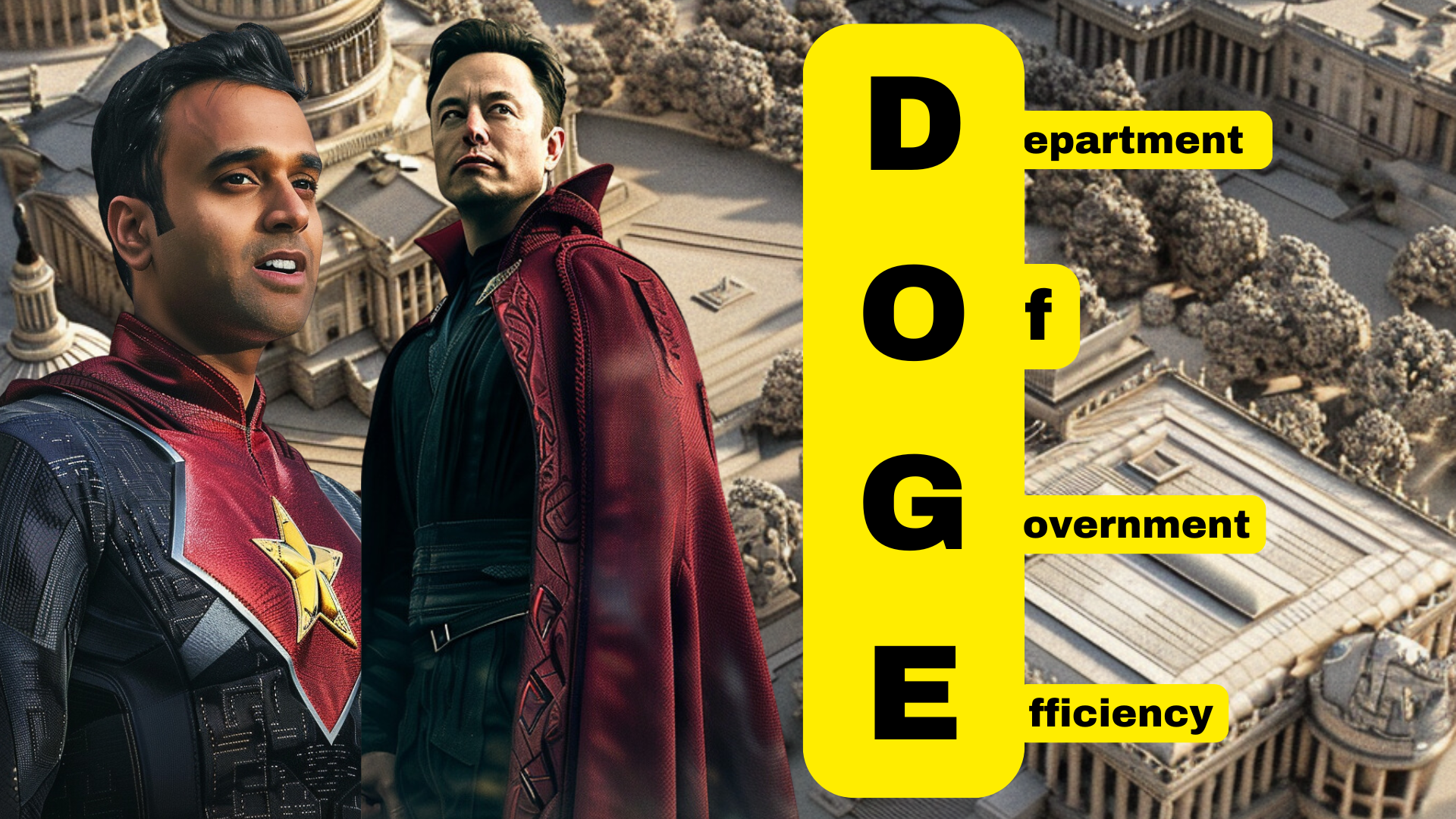Government Wasteful Spending: Department of Efficiency Cutting $2 Trillion

Introduction
The Department of Government Efficiency, better known as DOGE, is making waves with an ambitious plan to cut $2 trillion in wasteful government spending. Headed by tech titan Elon Musk and businessman Vivek Ramaswamy, this initiative aims to streamline federal operations and reduce unnecessary expenses. It’s a huge challenge that, if successful, could reshape the way Washington works. But is it achievable, or just another unrealistic promise? In this article, we’ll break down the DOGE initiative, the hurdles it faces, and whether or not it stands a chance of success.
Things to Know About DOGE
- Who is Leading DOGE? Elon Musk and Vivek Ramaswamy are at the helm. Musk, known for his ventures like Tesla and SpaceX, has never shied away from taking on big challenges. Ramaswamy, meanwhile, brings a sharp business mindset and a willingness to shake things up politically. Together, they’re taking on an enormous task: cutting $2 trillion in wasteful spending from the federal budget.
- What is the Goal? The goal is to reduce inefficiencies across all federal agencies. That means merging redundant programs, eliminating outdated regulations, and possibly restructuring entire departments. Essentially, Musk and Ramaswamy want to make government operations as streamlined as a Tesla assembly line.
- How Much Waste is Really Out There? According to the Government Accountability Office (GAO), there are many opportunities to reduce overlap and duplication in federal programs. However, the scope of the waste is vast, and pinpointing the specific areas to cut is no easy task. Many have tried before, but the scale of the inefficiency is daunting.
Identifying Government Waste
Identifying government waste is a crucial step in reducing unnecessary spending and promoting fiscal responsibility. Government waste can take many forms, including inefficient programs, duplicate services, and mismanagement of taxpayer funds. To tackle this issue, it’s essential to analyze federal programs and agencies, as well as their spending habits.
One effective way to identify government waste is by reviewing the reports and recommendations of the Government Accountability Office (GAO). The GAO is an independent agency that oversees and analyzes federal government spending. Their reports often highlight areas of wasteful spending and provide actionable recommendations for improvement. By leveraging the insights from the GAO, we can pinpoint inefficiencies and take steps to address them.
Another approach is to scrutinize federal agencies’ budgets and spending habits. This involves reviewing the agencies’ budget requests and comparing them to their actual spending patterns. By analyzing this information, we can identify areas where agencies may be wasting taxpayer funds. For instance, if an agency consistently requests more funds than it needs or fails to spend its allocated budget effectively, it could be a red flag for wasteful spending.
In summary, identifying government waste requires a thorough examination of federal programs and agencies and their spending habits. By utilizing resources like the GAO and conducting detailed budget analyses, we can uncover inefficiency and work towards a more fiscally responsible federal government.
Sources of Wasteful Spending in the Federal Government

There are several sources of wasteful spending in the federal government, each contributing to the inefficiencies that DOGE aims to eliminate. One of the primary sources is inefficient programs and services. Many federal programs are outdated or ineffective, yet they continue to receive funding. For example, the Congressional Budget Office (CBO) has identified numerous programs that are no longer authorized by federal law but still receive financial support. This misallocation of taxpayer funds is a significant source of waste.
Another major source of wasteful spending is duplicate services. Many federal agencies provide similar services, leading to a duplication of effort and a waste of taxpayer funds. For instance, both the Department of Health and Human Services (HHS) and the Department of Education offer services related to healthcare and education. This overlap results in redundant efforts and unnecessary expenditures, which could be streamlined to save taxpayer money.
Mismanagement of taxpayer funds is also a significant contributor to wasteful spending. Federal agencies often fail to properly track and account for their spending, leading to waste and abuse of taxpayer funds. This mismanagement can take various forms, from overpaying for goods and services to failing to utilize allocated funds efficiently. Addressing these issues requires robust oversight and accountability measures to ensure taxpayer funds are used effectively.
In conclusion, the primary sources of wasteful spending in the federal government include inefficient programs, duplicate services, and mismanagement of taxpayer funds. By addressing these issues, we can reduce wasteful spending and promote a more efficient and fiscally responsible federal government.
The Challenges of Cutting $2 Trillion
Cutting $2 trillion from the federal budget will not be easy. Some experts argue that involving the private sector in certain government functions could lead to more efficient and cost-effective solutions. The federal budget is complex, and a significant portion—about two-thirds—goes to mandatory spending, like Social Security and Medicare. This means that most of the cuts would need to come from the remaining one-third of discretionary spending.
Bureaucratic and Political Hurdles
Reducing government spending on this scale will require approval from Congress, and that’s where things could get tricky. Every federal program has its supporters, whether it’s politicians who see the benefit to their constituents or agencies that rely on those funds to operate. Musk and Ramaswamy might have fresh ideas, but they’ll need to navigate a complicated political landscape.
Forbes highlights how difficult it can be to cut federal spending when everyone wants to protect their slice of the pie. The government can be like that friend who insists on ordering a bunch of appetizers no one asked for and then conveniently forgets to split the check. Everyone wants to cut costs—until it impacts something they care about.
Consequences of Government Waste
The consequences of government waste are far-reaching and can significantly impact taxpayers and the economy. One of the primary consequences is the waste of taxpayer funds. When the government wastes taxpayer funds, it means that those funds are not being used for their intended purpose. This can result in a lack of funding for essential programs and services, ultimately affecting the quality of services provided to the public.
Another consequence of government waste is its negative impact on the economy. When the government wastes taxpayer funds, it can lead to inflation and decreased economic growth. This can have a ripple effect on businesses and individuals, resulting in higher prices and reduced economic opportunities. For example, inefficient government spending can lead to higher taxes, burdening businesses and stifle economic innovation.
Finally, government waste can also lead to a lack of trust in government institutions. When taxpayers see that their funds are being wasted, they may become disillusioned with the government’s ability to manage taxpayer funds effectively. This erosion of trust can lead to decreased civic engagement and a lack of confidence in government institutions. In the long run, this can undermine the government’s ability to implement policies and programs that benefit the public.
In conclusion, the consequences of government waste are significant and far-reaching. They include the waste of taxpayer funds, negative impacts on the economy, and a loss of trust in government institutions. Addressing government waste is essential for promoting fiscal responsibility and ensuring that taxpayer funds are used effectively to benefit the public.
Real Examples of Government Efficiency Initiatives to Combat Wasteful Government Spending
DOGE isn’t the first attempt to overhaul government spending. Back in the 1980s, President Reagan established the Grace Commission to identify waste in federal spending. The commission found plenty of areas for improvement, but implementing those recommendations proved to be extremely challenging due to political and bureaucratic resistance. The Grace Commission serves as a reminder of just how difficult it is to enact meaningful change at the federal level.
Another example is the more recent effort by the U.S. Government Accountability Office (GAO). Over the years, the GAO has issued hundreds of reports detailing overlapping programs and inefficiencies. While some of their recommendations have been implemented, the progress has been slow, and the total savings have not come close to $2 trillion.
What Could Happen if DOGE Succeeds?
If DOGE manages to succeed, the impact could be massive. We could see fewer redundant federal agencies, a more streamlined government workforce, and potentially a reduction in the federal deficit. It would be a win for taxpayers, who have long complained about inefficiencies and waste in Washington. Imagine a government that works more like a lean startup—fast, efficient, and results-driven.
However, experts are skeptical. Cutting that much spending without affecting essential services is a monumental challenge. Mandatory spending programs like Social Security and Medicare are politically untouchable, and trimming $2 trillion from discretionary spending means tough decisions will have to be made. The question is: will Congress be willing to make those cuts?
FAQ About DOGE and Government Spending of Taxpayer Money

1. What exactly is DOGE? DOGE stands for the Department of Government Efficiency. It’s an advisory commission led by Elon Musk and Vivek Ramaswamy, aimed at reducing wasteful federal spending.
2. Why is $2 trillion the target? The $2 trillion figure represents a significant chunk of the federal budget that Musk and Ramaswamy believe can be saved through better efficiency and eliminating redundancy. It’s an ambitious goal, but one they think is achievable.
3. What challenges will DOGE face? The biggest challenges are political resistance, bureaucratic inertia, and the fact that a lot of federal spending is mandatory, meaning it’s legally required and cannot be easily cut.
4. Has anything like this been attempted before? Yes, similar efforts like the Grace Commission in the 1980s and ongoing recommendations by the GAO have aimed to cut wasteful spending. However, their success has been limited due to political and bureaucratic barriers.
5. How long will it take to see results? Even if DOGE’s recommendations are accepted, the changes will take time to implement. Government overhaul is a slow process, and the results might not be seen for years.
Can DOGE Actually Make a Difference?
Elon Musk and Vivek Ramaswamy have set their sights on making government more efficient—something that sounds good on paper but has proven to be incredibly challenging in practice. The idea of cutting $2 trillion in wasteful spending is ambitious, and if anyone has the boldness to try it, it’s Musk. But the reality of navigating bureaucratic roadblocks and political interests might prove to be the ultimate test of his problem-solving skills.
It’s easy to be skeptical, but also hard not to be at least a little bit hopeful. A more efficient government could mean lower taxes, better services, and less waste. Whether DOGE can deliver on those promises remains to be seen.
What do you think? Is DOGE a game-changing initiative that will finally tackle government inefficiency, or just another pipe dream destined to be forgotten? Let us know in the comments below.
Want to Learn More?
- The Government Accountability Office’s Efforts to Reduce Waste
- The Grace Commission and Its Legacy
- Forbes on the Challenges of Federal Spending Cuts
Stay informed, stay curious, and until next time—let’s keep pushing for a government that works for all of us.
Related Terms: federal government wastes, government officials, fiscal year, federal agency, tax dollars, social security administration, financial benefits













